Detailed Analysis of Networking Connectivity and Devices
VerifiedAdded on 2019/09/24
|10
|3015
|98
Essay
AI Summary
This blog post provides a detailed overview of networking connectivity, explaining the process of connecting network components for communication. It begins by defining networking connectivity and then delves into the basics of computer networks, differentiating between peer-to-peer and client/server networks. The essay then explores major networking devices, including the network interface card (NIC), hub, switch, bridge, router, gateway, modem, wireless access points, firewall, and transceivers. Each device's function and role within a network are explained, offering insights into how data is transmitted and how networks are secured. The post emphasizes the importance of these components in enabling data sharing and communication across networks. The explanation of these components includes how hubs, switches, routers, and firewalls contribute to efficient data transfer and network security. It highlights the complexity and functionality of each device within a network, providing a comprehensive guide to understanding how networks operate and maintain connectivity.

Running head: Blog writing
BLOG WRITING
BLOG WRITING
Paraphrase This Document
Need a fresh take? Get an instant paraphrase of this document with our AI Paraphraser
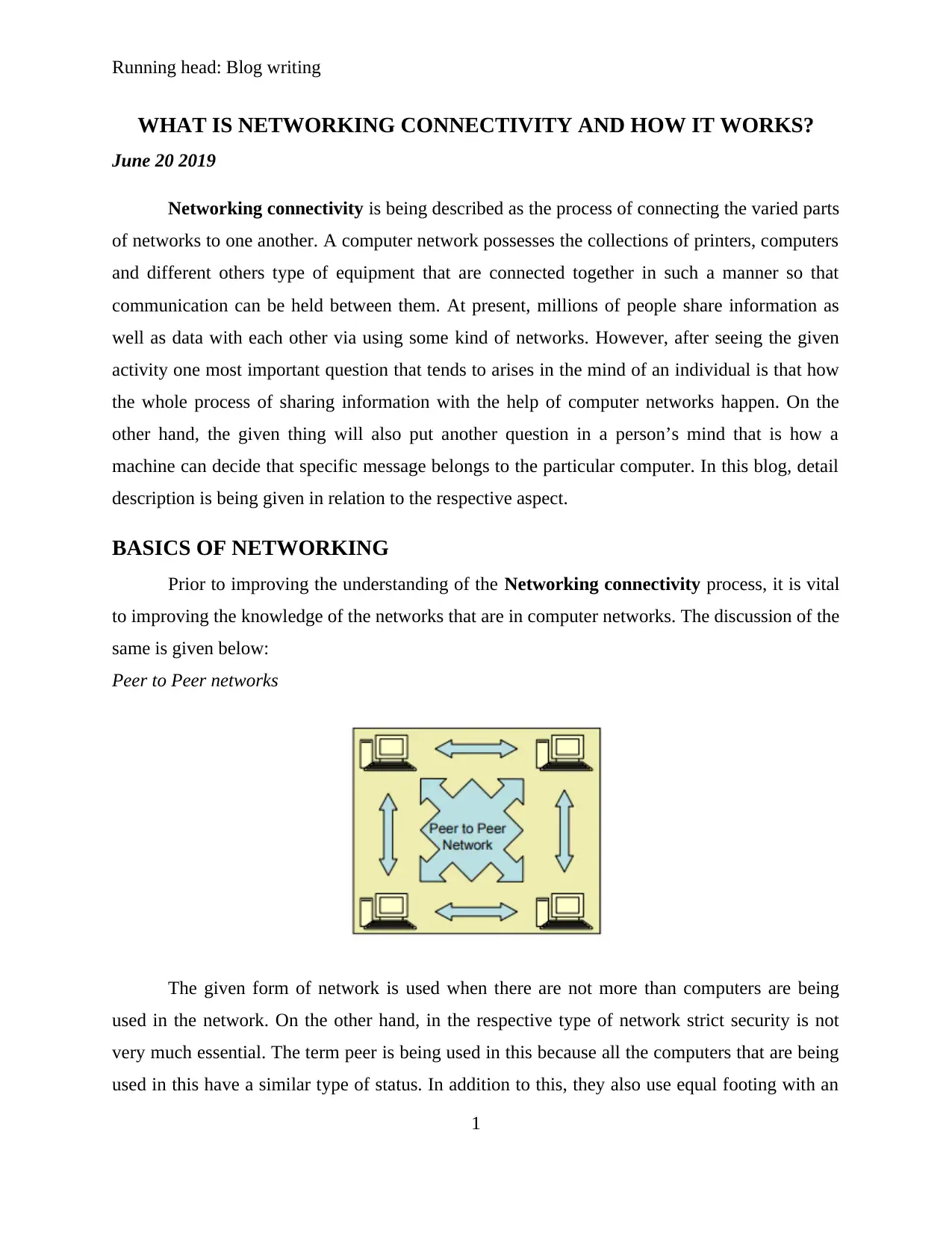
Running head: Blog writing
WHAT IS NETWORKING CONNECTIVITY AND HOW IT WORKS?
June 20 2019
Networking connectivity is being described as the process of connecting the varied parts
of networks to one another. A computer network possesses the collections of printers, computers
and different others type of equipment that are connected together in such a manner so that
communication can be held between them. At present, millions of people share information as
well as data with each other via using some kind of networks. However, after seeing the given
activity one most important question that tends to arises in the mind of an individual is that how
the whole process of sharing information with the help of computer networks happen. On the
other hand, the given thing will also put another question in a person’s mind that is how a
machine can decide that specific message belongs to the particular computer. In this blog, detail
description is being given in relation to the respective aspect.
BASICS OF NETWORKING
Prior to improving the understanding of the Networking connectivity process, it is vital
to improving the knowledge of the networks that are in computer networks. The discussion of the
same is given below:
Peer to Peer networks
The given form of network is used when there are not more than computers are being
used in the network. On the other hand, in the respective type of network strict security is not
very much essential. The term peer is being used in this because all the computers that are being
used in this have a similar type of status. In addition to this, they also use equal footing with an
1
WHAT IS NETWORKING CONNECTIVITY AND HOW IT WORKS?
June 20 2019
Networking connectivity is being described as the process of connecting the varied parts
of networks to one another. A computer network possesses the collections of printers, computers
and different others type of equipment that are connected together in such a manner so that
communication can be held between them. At present, millions of people share information as
well as data with each other via using some kind of networks. However, after seeing the given
activity one most important question that tends to arises in the mind of an individual is that how
the whole process of sharing information with the help of computer networks happen. On the
other hand, the given thing will also put another question in a person’s mind that is how a
machine can decide that specific message belongs to the particular computer. In this blog, detail
description is being given in relation to the respective aspect.
BASICS OF NETWORKING
Prior to improving the understanding of the Networking connectivity process, it is vital
to improving the knowledge of the networks that are in computer networks. The discussion of the
same is given below:
Peer to Peer networks
The given form of network is used when there are not more than computers are being
used in the network. On the other hand, in the respective type of network strict security is not
very much essential. The term peer is being used in this because all the computers that are being
used in this have a similar type of status. In addition to this, they also use equal footing with an
1
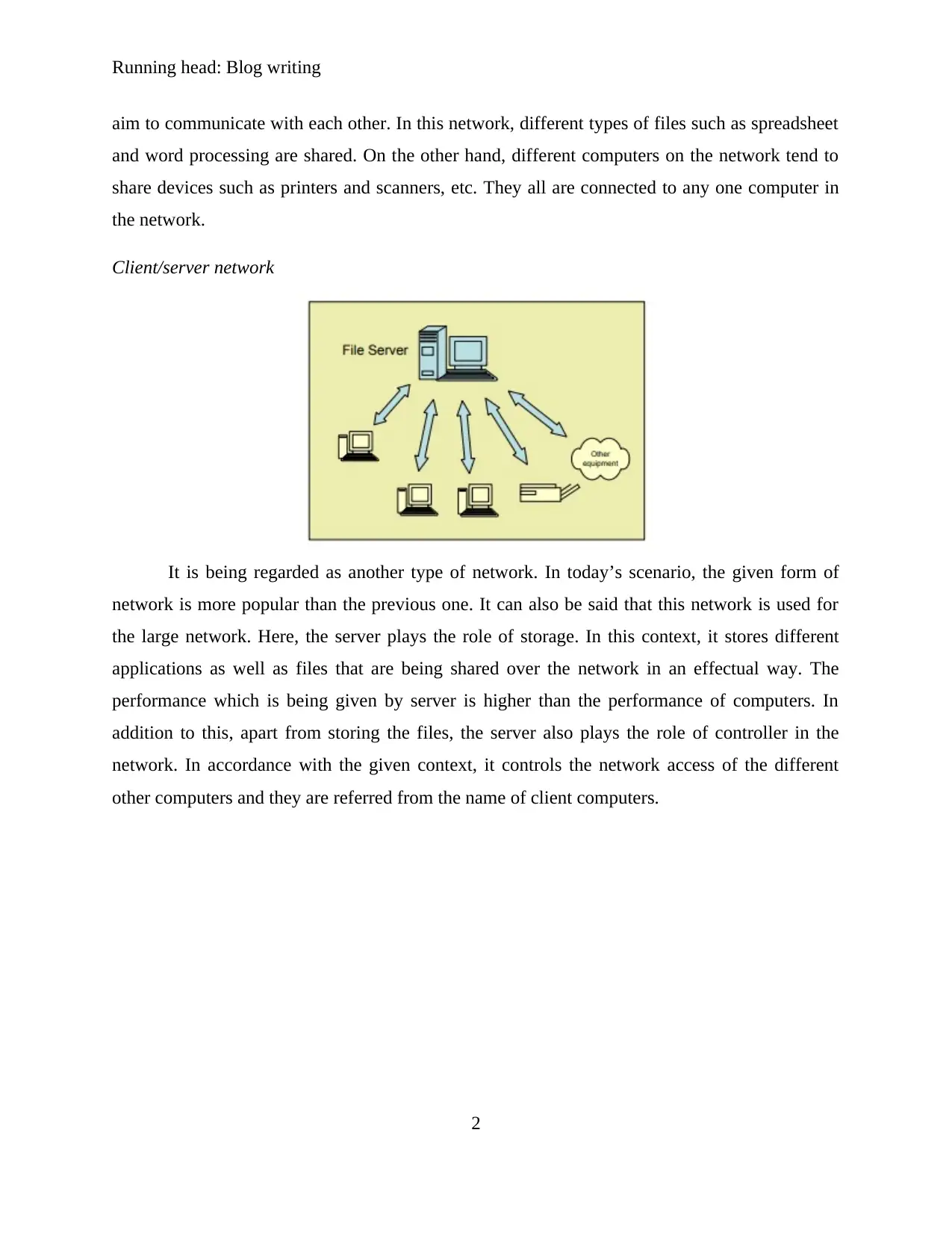
Running head: Blog writing
aim to communicate with each other. In this network, different types of files such as spreadsheet
and word processing are shared. On the other hand, different computers on the network tend to
share devices such as printers and scanners, etc. They all are connected to any one computer in
the network.
Client/server network
It is being regarded as another type of network. In today’s scenario, the given form of
network is more popular than the previous one. It can also be said that this network is used for
the large network. Here, the server plays the role of storage. In this context, it stores different
applications as well as files that are being shared over the network in an effectual way. The
performance which is being given by server is higher than the performance of computers. In
addition to this, apart from storing the files, the server also plays the role of controller in the
network. In accordance with the given context, it controls the network access of the different
other computers and they are referred from the name of client computers.
2
aim to communicate with each other. In this network, different types of files such as spreadsheet
and word processing are shared. On the other hand, different computers on the network tend to
share devices such as printers and scanners, etc. They all are connected to any one computer in
the network.
Client/server network
It is being regarded as another type of network. In today’s scenario, the given form of
network is more popular than the previous one. It can also be said that this network is used for
the large network. Here, the server plays the role of storage. In this context, it stores different
applications as well as files that are being shared over the network in an effectual way. The
performance which is being given by server is higher than the performance of computers. In
addition to this, apart from storing the files, the server also plays the role of controller in the
network. In accordance with the given context, it controls the network access of the different
other computers and they are referred from the name of client computers.
2
⊘ This is a preview!⊘
Do you want full access?
Subscribe today to unlock all pages.

Trusted by 1+ million students worldwide
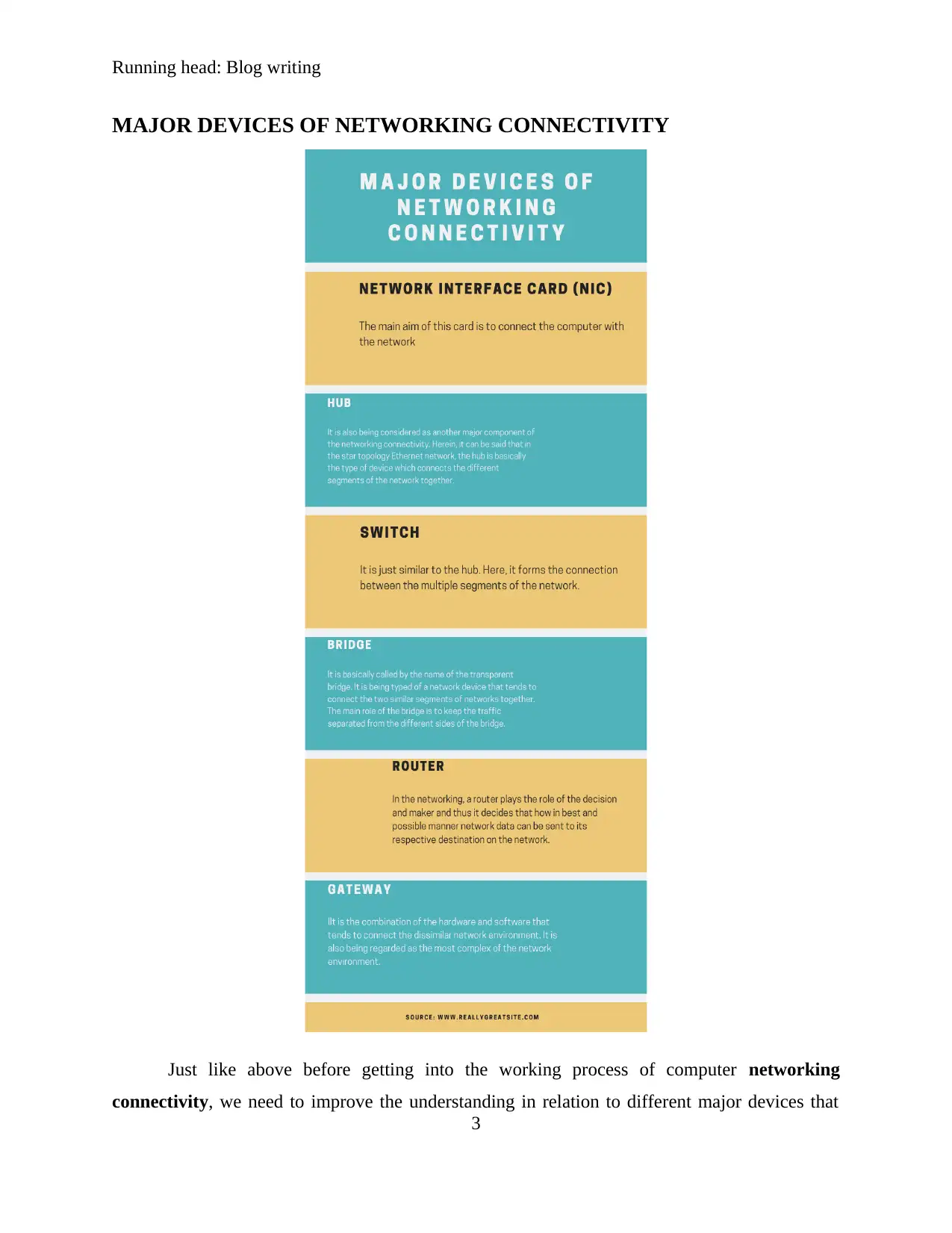
Running head: Blog writing
MAJOR DEVICES OF NETWORKING CONNECTIVITY
Just like above before getting into the working process of computer networking
connectivity, we need to improve the understanding in relation to different major devices that
3
MAJOR DEVICES OF NETWORKING CONNECTIVITY
Just like above before getting into the working process of computer networking
connectivity, we need to improve the understanding in relation to different major devices that
3
Paraphrase This Document
Need a fresh take? Get an instant paraphrase of this document with our AI Paraphraser
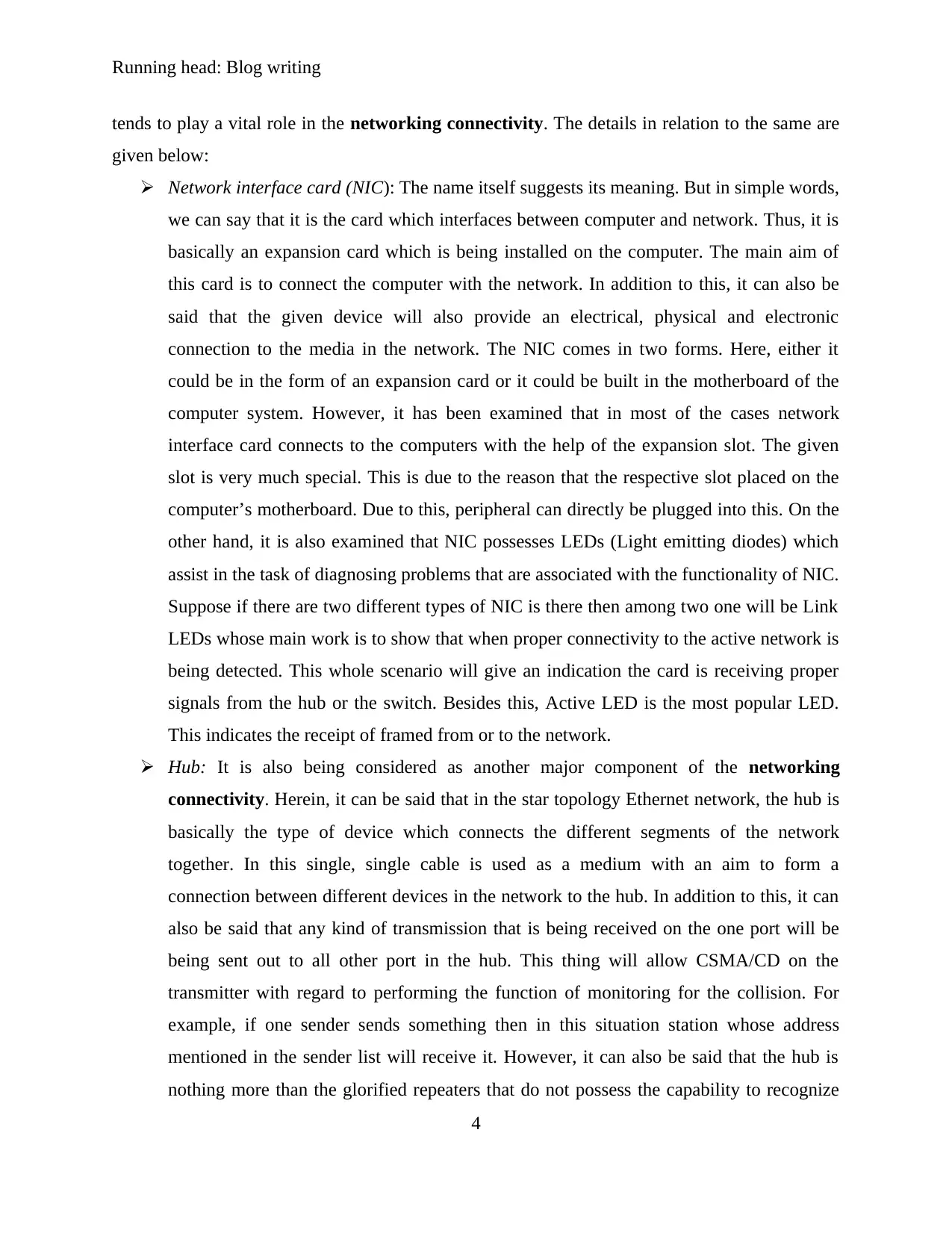
Running head: Blog writing
tends to play a vital role in the networking connectivity. The details in relation to the same are
given below:
Network interface card (NIC): The name itself suggests its meaning. But in simple words,
we can say that it is the card which interfaces between computer and network. Thus, it is
basically an expansion card which is being installed on the computer. The main aim of
this card is to connect the computer with the network. In addition to this, it can also be
said that the given device will also provide an electrical, physical and electronic
connection to the media in the network. The NIC comes in two forms. Here, either it
could be in the form of an expansion card or it could be built in the motherboard of the
computer system. However, it has been examined that in most of the cases network
interface card connects to the computers with the help of the expansion slot. The given
slot is very much special. This is due to the reason that the respective slot placed on the
computer’s motherboard. Due to this, peripheral can directly be plugged into this. On the
other hand, it is also examined that NIC possesses LEDs (Light emitting diodes) which
assist in the task of diagnosing problems that are associated with the functionality of NIC.
Suppose if there are two different types of NIC is there then among two one will be Link
LEDs whose main work is to show that when proper connectivity to the active network is
being detected. This whole scenario will give an indication the card is receiving proper
signals from the hub or the switch. Besides this, Active LED is the most popular LED.
This indicates the receipt of framed from or to the network.
Hub: It is also being considered as another major component of the networking
connectivity. Herein, it can be said that in the star topology Ethernet network, the hub is
basically the type of device which connects the different segments of the network
together. In this single, single cable is used as a medium with an aim to form a
connection between different devices in the network to the hub. In addition to this, it can
also be said that any kind of transmission that is being received on the one port will be
being sent out to all other port in the hub. This thing will allow CSMA/CD on the
transmitter with regard to performing the function of monitoring for the collision. For
example, if one sender sends something then in this situation station whose address
mentioned in the sender list will receive it. However, it can also be said that the hub is
nothing more than the glorified repeaters that do not possess the capability to recognize
4
tends to play a vital role in the networking connectivity. The details in relation to the same are
given below:
Network interface card (NIC): The name itself suggests its meaning. But in simple words,
we can say that it is the card which interfaces between computer and network. Thus, it is
basically an expansion card which is being installed on the computer. The main aim of
this card is to connect the computer with the network. In addition to this, it can also be
said that the given device will also provide an electrical, physical and electronic
connection to the media in the network. The NIC comes in two forms. Here, either it
could be in the form of an expansion card or it could be built in the motherboard of the
computer system. However, it has been examined that in most of the cases network
interface card connects to the computers with the help of the expansion slot. The given
slot is very much special. This is due to the reason that the respective slot placed on the
computer’s motherboard. Due to this, peripheral can directly be plugged into this. On the
other hand, it is also examined that NIC possesses LEDs (Light emitting diodes) which
assist in the task of diagnosing problems that are associated with the functionality of NIC.
Suppose if there are two different types of NIC is there then among two one will be Link
LEDs whose main work is to show that when proper connectivity to the active network is
being detected. This whole scenario will give an indication the card is receiving proper
signals from the hub or the switch. Besides this, Active LED is the most popular LED.
This indicates the receipt of framed from or to the network.
Hub: It is also being considered as another major component of the networking
connectivity. Herein, it can be said that in the star topology Ethernet network, the hub is
basically the type of device which connects the different segments of the network
together. In this single, single cable is used as a medium with an aim to form a
connection between different devices in the network to the hub. In addition to this, it can
also be said that any kind of transmission that is being received on the one port will be
being sent out to all other port in the hub. This thing will allow CSMA/CD on the
transmitter with regard to performing the function of monitoring for the collision. For
example, if one sender sends something then in this situation station whose address
mentioned in the sender list will receive it. However, it can also be said that the hub is
nothing more than the glorified repeaters that do not possess the capability to recognize
4

Running head: Blog writing
the frame boundaries as well as data structures. It is due to the presence of a given aspect
only hubs play the act of tool which does not possess any intelligence.
Switch: The third major component which is used in the networking connectivity is
called by the name of the switch. It is just similar to the hub. Here, it forms the
connection between the multiple segments of the network. However, one major
difference that exists between hub and switch is that hubs do not possess any kind of
filter. Thus, whatever thing that hub receives over the network will be sent to all other
computers. But, in comparison to this the switch will basically recognize the frame
boundaries and give attention to the MAC address of the incoming frames and on the
basis of the given address switch will send the file to the correct the address. However, if
file send does not possess any recognizable address then in the given situation it will be
again sent to the sender location. In addition to this, in many satiations switch will play
the role like a hub. For example, the location of the destination is not known then in the
given situation switch will react much like a hub and as a result of this it floods out the
frame at each and every port. However, except for the port over which it is being
received. The switch is more effective than the hub because it is able to give support to
the full wire speed on every port.
Bridge: It is basically called by the name of the transparent bridge. It is being typed of a
network device that tends to connect the two similar segments of networks together. The
main role of the bridge is to keep the traffic separated from the different sides of the
bridge. From this, it can be said that the bridge is also function just like its name. Here,
information or the packets is being transmitted to the other side of the bridge if it is
intended for the station on the other side. In addition to this, it can also be said that the
main reason for using the bridge in the networking connectivity is to form the
connection between two segments and to divide the bust networks into two segments.
Router: It is being regarded as the most popular term which is being used in the
networking connectivity. This connects multiple segments of the network in the
internetwork. In the networking, a router plays the role of the decision and maker and
thus it decides that how in best and possible manner network data can be sent to its
respective destination on the network. However, it is to be evaluated that the work of the
router is very complex in nature. Here, CPU is dedicated to the task of routing different
5
the frame boundaries as well as data structures. It is due to the presence of a given aspect
only hubs play the act of tool which does not possess any intelligence.
Switch: The third major component which is used in the networking connectivity is
called by the name of the switch. It is just similar to the hub. Here, it forms the
connection between the multiple segments of the network. However, one major
difference that exists between hub and switch is that hubs do not possess any kind of
filter. Thus, whatever thing that hub receives over the network will be sent to all other
computers. But, in comparison to this the switch will basically recognize the frame
boundaries and give attention to the MAC address of the incoming frames and on the
basis of the given address switch will send the file to the correct the address. However, if
file send does not possess any recognizable address then in the given situation it will be
again sent to the sender location. In addition to this, in many satiations switch will play
the role like a hub. For example, the location of the destination is not known then in the
given situation switch will react much like a hub and as a result of this it floods out the
frame at each and every port. However, except for the port over which it is being
received. The switch is more effective than the hub because it is able to give support to
the full wire speed on every port.
Bridge: It is basically called by the name of the transparent bridge. It is being typed of a
network device that tends to connect the two similar segments of networks together. The
main role of the bridge is to keep the traffic separated from the different sides of the
bridge. From this, it can be said that the bridge is also function just like its name. Here,
information or the packets is being transmitted to the other side of the bridge if it is
intended for the station on the other side. In addition to this, it can also be said that the
main reason for using the bridge in the networking connectivity is to form the
connection between two segments and to divide the bust networks into two segments.
Router: It is being regarded as the most popular term which is being used in the
networking connectivity. This connects multiple segments of the network in the
internetwork. In the networking, a router plays the role of the decision and maker and
thus it decides that how in best and possible manner network data can be sent to its
respective destination on the network. However, it is to be evaluated that the work of the
router is very complex in nature. Here, CPU is dedicated to the task of routing different
5
⊘ This is a preview!⊘
Do you want full access?
Subscribe today to unlock all pages.

Trusted by 1+ million students worldwide
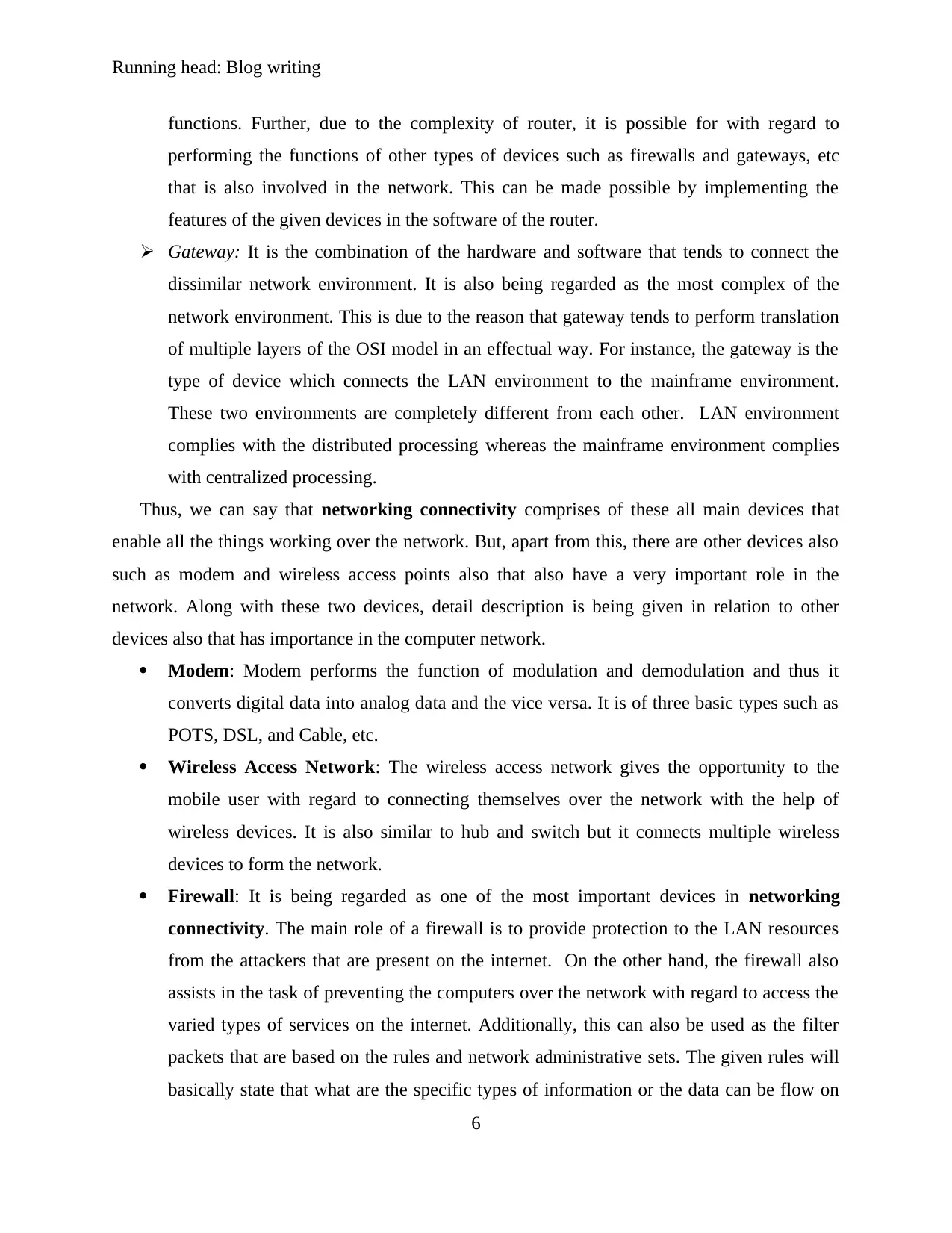
Running head: Blog writing
functions. Further, due to the complexity of router, it is possible for with regard to
performing the functions of other types of devices such as firewalls and gateways, etc
that is also involved in the network. This can be made possible by implementing the
features of the given devices in the software of the router.
Gateway: It is the combination of the hardware and software that tends to connect the
dissimilar network environment. It is also being regarded as the most complex of the
network environment. This is due to the reason that gateway tends to perform translation
of multiple layers of the OSI model in an effectual way. For instance, the gateway is the
type of device which connects the LAN environment to the mainframe environment.
These two environments are completely different from each other. LAN environment
complies with the distributed processing whereas the mainframe environment complies
with centralized processing.
Thus, we can say that networking connectivity comprises of these all main devices that
enable all the things working over the network. But, apart from this, there are other devices also
such as modem and wireless access points also that also have a very important role in the
network. Along with these two devices, detail description is being given in relation to other
devices also that has importance in the computer network.
Modem: Modem performs the function of modulation and demodulation and thus it
converts digital data into analog data and the vice versa. It is of three basic types such as
POTS, DSL, and Cable, etc.
Wireless Access Network: The wireless access network gives the opportunity to the
mobile user with regard to connecting themselves over the network with the help of
wireless devices. It is also similar to hub and switch but it connects multiple wireless
devices to form the network.
Firewall: It is being regarded as one of the most important devices in networking
connectivity. The main role of a firewall is to provide protection to the LAN resources
from the attackers that are present on the internet. On the other hand, the firewall also
assists in the task of preventing the computers over the network with regard to access the
varied types of services on the internet. Additionally, this can also be used as the filter
packets that are based on the rules and network administrative sets. The given rules will
basically state that what are the specific types of information or the data can be flow on
6
functions. Further, due to the complexity of router, it is possible for with regard to
performing the functions of other types of devices such as firewalls and gateways, etc
that is also involved in the network. This can be made possible by implementing the
features of the given devices in the software of the router.
Gateway: It is the combination of the hardware and software that tends to connect the
dissimilar network environment. It is also being regarded as the most complex of the
network environment. This is due to the reason that gateway tends to perform translation
of multiple layers of the OSI model in an effectual way. For instance, the gateway is the
type of device which connects the LAN environment to the mainframe environment.
These two environments are completely different from each other. LAN environment
complies with the distributed processing whereas the mainframe environment complies
with centralized processing.
Thus, we can say that networking connectivity comprises of these all main devices that
enable all the things working over the network. But, apart from this, there are other devices also
such as modem and wireless access points also that also have a very important role in the
network. Along with these two devices, detail description is being given in relation to other
devices also that has importance in the computer network.
Modem: Modem performs the function of modulation and demodulation and thus it
converts digital data into analog data and the vice versa. It is of three basic types such as
POTS, DSL, and Cable, etc.
Wireless Access Network: The wireless access network gives the opportunity to the
mobile user with regard to connecting themselves over the network with the help of
wireless devices. It is also similar to hub and switch but it connects multiple wireless
devices to form the network.
Firewall: It is being regarded as one of the most important devices in networking
connectivity. The main role of a firewall is to provide protection to the LAN resources
from the attackers that are present on the internet. On the other hand, the firewall also
assists in the task of preventing the computers over the network with regard to access the
varied types of services on the internet. Additionally, this can also be used as the filter
packets that are based on the rules and network administrative sets. The given rules will
basically state that what are the specific types of information or the data can be flow on
6
Paraphrase This Document
Need a fresh take? Get an instant paraphrase of this document with our AI Paraphraser
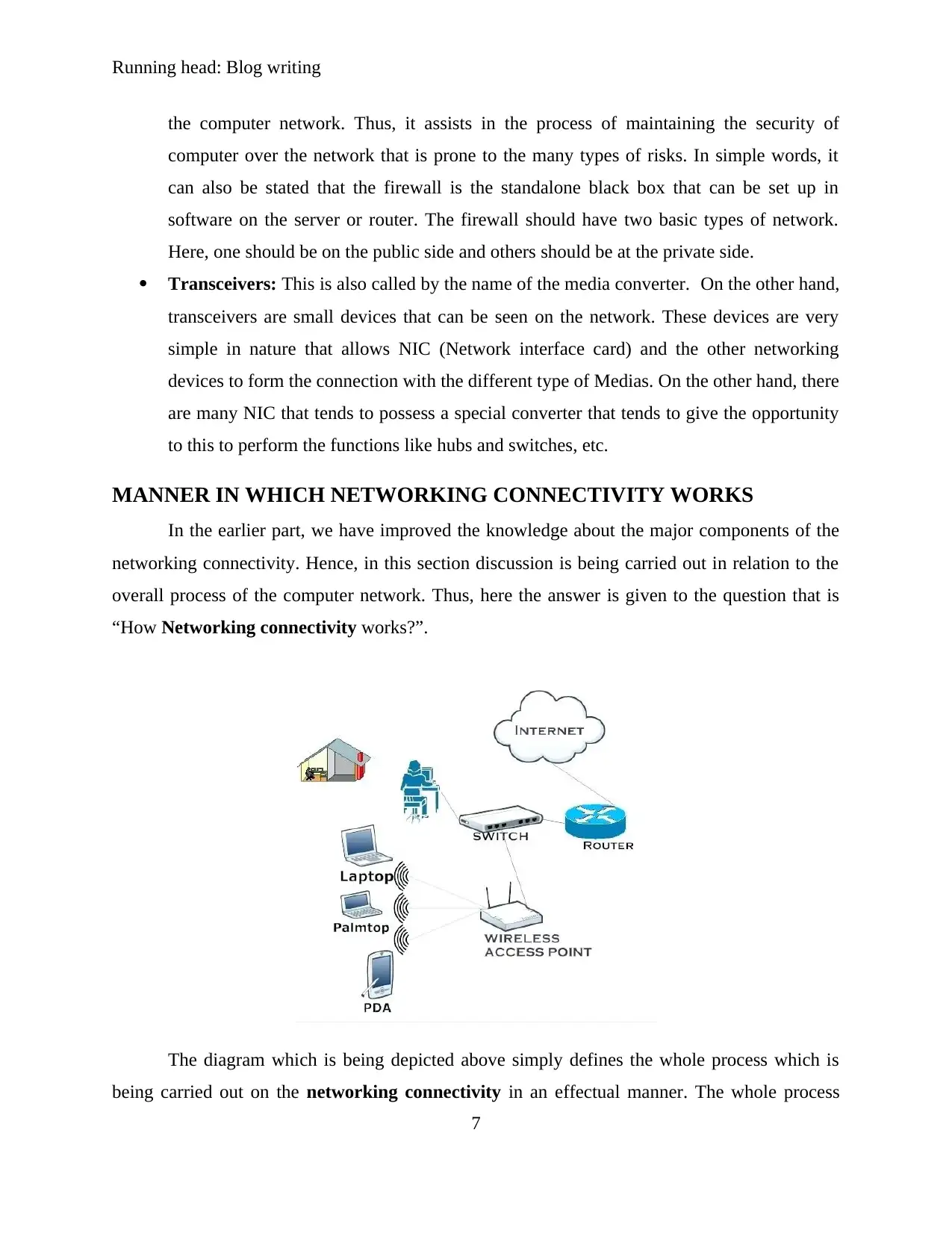
Running head: Blog writing
the computer network. Thus, it assists in the process of maintaining the security of
computer over the network that is prone to the many types of risks. In simple words, it
can also be stated that the firewall is the standalone black box that can be set up in
software on the server or router. The firewall should have two basic types of network.
Here, one should be on the public side and others should be at the private side.
Transceivers: This is also called by the name of the media converter. On the other hand,
transceivers are small devices that can be seen on the network. These devices are very
simple in nature that allows NIC (Network interface card) and the other networking
devices to form the connection with the different type of Medias. On the other hand, there
are many NIC that tends to possess a special converter that tends to give the opportunity
to this to perform the functions like hubs and switches, etc.
MANNER IN WHICH NETWORKING CONNECTIVITY WORKS
In the earlier part, we have improved the knowledge about the major components of the
networking connectivity. Hence, in this section discussion is being carried out in relation to the
overall process of the computer network. Thus, here the answer is given to the question that is
“How Networking connectivity works?”.
The diagram which is being depicted above simply defines the whole process which is
being carried out on the networking connectivity in an effectual manner. The whole process
7
the computer network. Thus, it assists in the process of maintaining the security of
computer over the network that is prone to the many types of risks. In simple words, it
can also be stated that the firewall is the standalone black box that can be set up in
software on the server or router. The firewall should have two basic types of network.
Here, one should be on the public side and others should be at the private side.
Transceivers: This is also called by the name of the media converter. On the other hand,
transceivers are small devices that can be seen on the network. These devices are very
simple in nature that allows NIC (Network interface card) and the other networking
devices to form the connection with the different type of Medias. On the other hand, there
are many NIC that tends to possess a special converter that tends to give the opportunity
to this to perform the functions like hubs and switches, etc.
MANNER IN WHICH NETWORKING CONNECTIVITY WORKS
In the earlier part, we have improved the knowledge about the major components of the
networking connectivity. Hence, in this section discussion is being carried out in relation to the
overall process of the computer network. Thus, here the answer is given to the question that is
“How Networking connectivity works?”.
The diagram which is being depicted above simply defines the whole process which is
being carried out on the networking connectivity in an effectual manner. The whole process
7
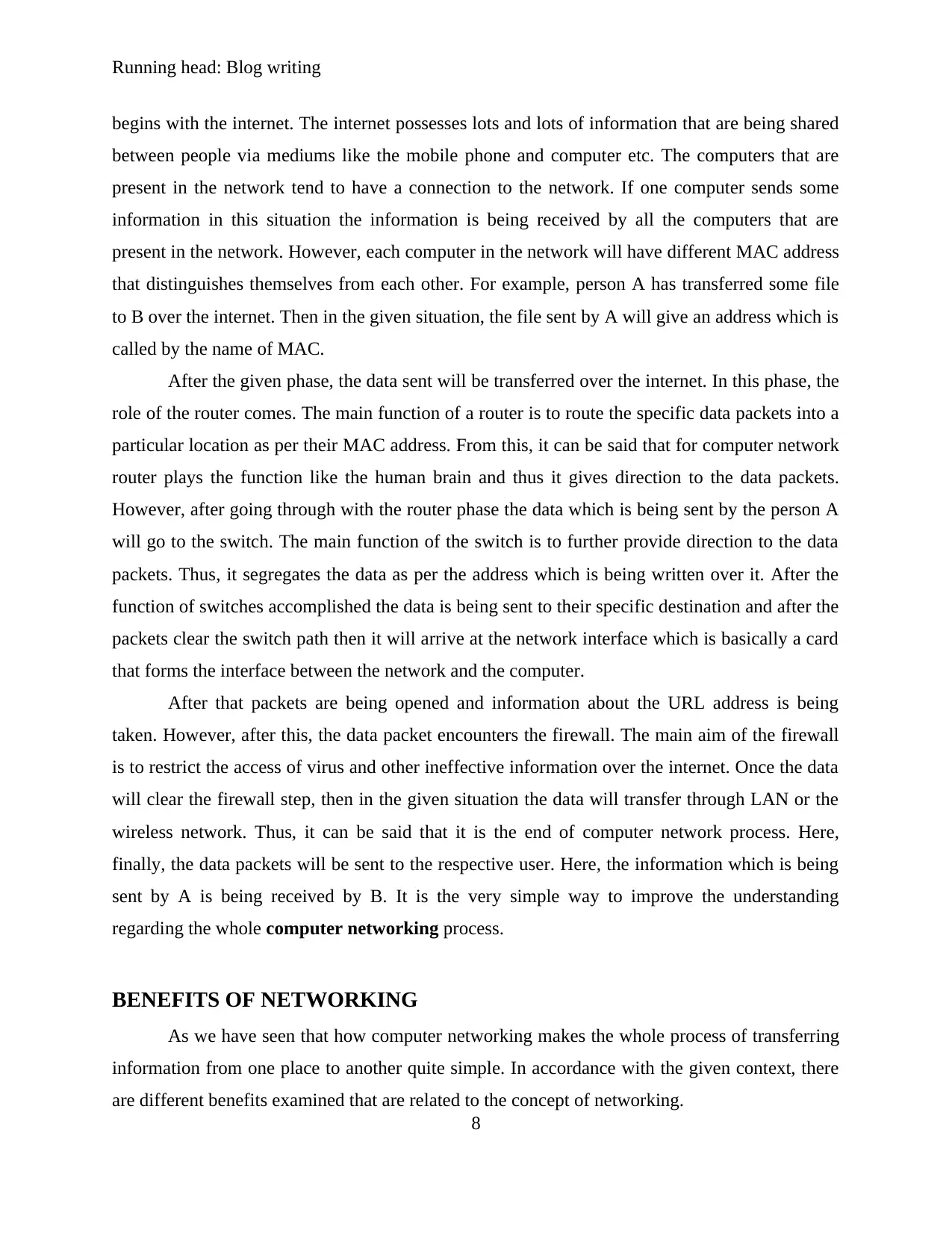
Running head: Blog writing
begins with the internet. The internet possesses lots and lots of information that are being shared
between people via mediums like the mobile phone and computer etc. The computers that are
present in the network tend to have a connection to the network. If one computer sends some
information in this situation the information is being received by all the computers that are
present in the network. However, each computer in the network will have different MAC address
that distinguishes themselves from each other. For example, person A has transferred some file
to B over the internet. Then in the given situation, the file sent by A will give an address which is
called by the name of MAC.
After the given phase, the data sent will be transferred over the internet. In this phase, the
role of the router comes. The main function of a router is to route the specific data packets into a
particular location as per their MAC address. From this, it can be said that for computer network
router plays the function like the human brain and thus it gives direction to the data packets.
However, after going through with the router phase the data which is being sent by the person A
will go to the switch. The main function of the switch is to further provide direction to the data
packets. Thus, it segregates the data as per the address which is being written over it. After the
function of switches accomplished the data is being sent to their specific destination and after the
packets clear the switch path then it will arrive at the network interface which is basically a card
that forms the interface between the network and the computer.
After that packets are being opened and information about the URL address is being
taken. However, after this, the data packet encounters the firewall. The main aim of the firewall
is to restrict the access of virus and other ineffective information over the internet. Once the data
will clear the firewall step, then in the given situation the data will transfer through LAN or the
wireless network. Thus, it can be said that it is the end of computer network process. Here,
finally, the data packets will be sent to the respective user. Here, the information which is being
sent by A is being received by B. It is the very simple way to improve the understanding
regarding the whole computer networking process.
BENEFITS OF NETWORKING
As we have seen that how computer networking makes the whole process of transferring
information from one place to another quite simple. In accordance with the given context, there
are different benefits examined that are related to the concept of networking.
8
begins with the internet. The internet possesses lots and lots of information that are being shared
between people via mediums like the mobile phone and computer etc. The computers that are
present in the network tend to have a connection to the network. If one computer sends some
information in this situation the information is being received by all the computers that are
present in the network. However, each computer in the network will have different MAC address
that distinguishes themselves from each other. For example, person A has transferred some file
to B over the internet. Then in the given situation, the file sent by A will give an address which is
called by the name of MAC.
After the given phase, the data sent will be transferred over the internet. In this phase, the
role of the router comes. The main function of a router is to route the specific data packets into a
particular location as per their MAC address. From this, it can be said that for computer network
router plays the function like the human brain and thus it gives direction to the data packets.
However, after going through with the router phase the data which is being sent by the person A
will go to the switch. The main function of the switch is to further provide direction to the data
packets. Thus, it segregates the data as per the address which is being written over it. After the
function of switches accomplished the data is being sent to their specific destination and after the
packets clear the switch path then it will arrive at the network interface which is basically a card
that forms the interface between the network and the computer.
After that packets are being opened and information about the URL address is being
taken. However, after this, the data packet encounters the firewall. The main aim of the firewall
is to restrict the access of virus and other ineffective information over the internet. Once the data
will clear the firewall step, then in the given situation the data will transfer through LAN or the
wireless network. Thus, it can be said that it is the end of computer network process. Here,
finally, the data packets will be sent to the respective user. Here, the information which is being
sent by A is being received by B. It is the very simple way to improve the understanding
regarding the whole computer networking process.
BENEFITS OF NETWORKING
As we have seen that how computer networking makes the whole process of transferring
information from one place to another quite simple. In accordance with the given context, there
are different benefits examined that are related to the concept of networking.
8
⊘ This is a preview!⊘
Do you want full access?
Subscribe today to unlock all pages.

Trusted by 1+ million students worldwide
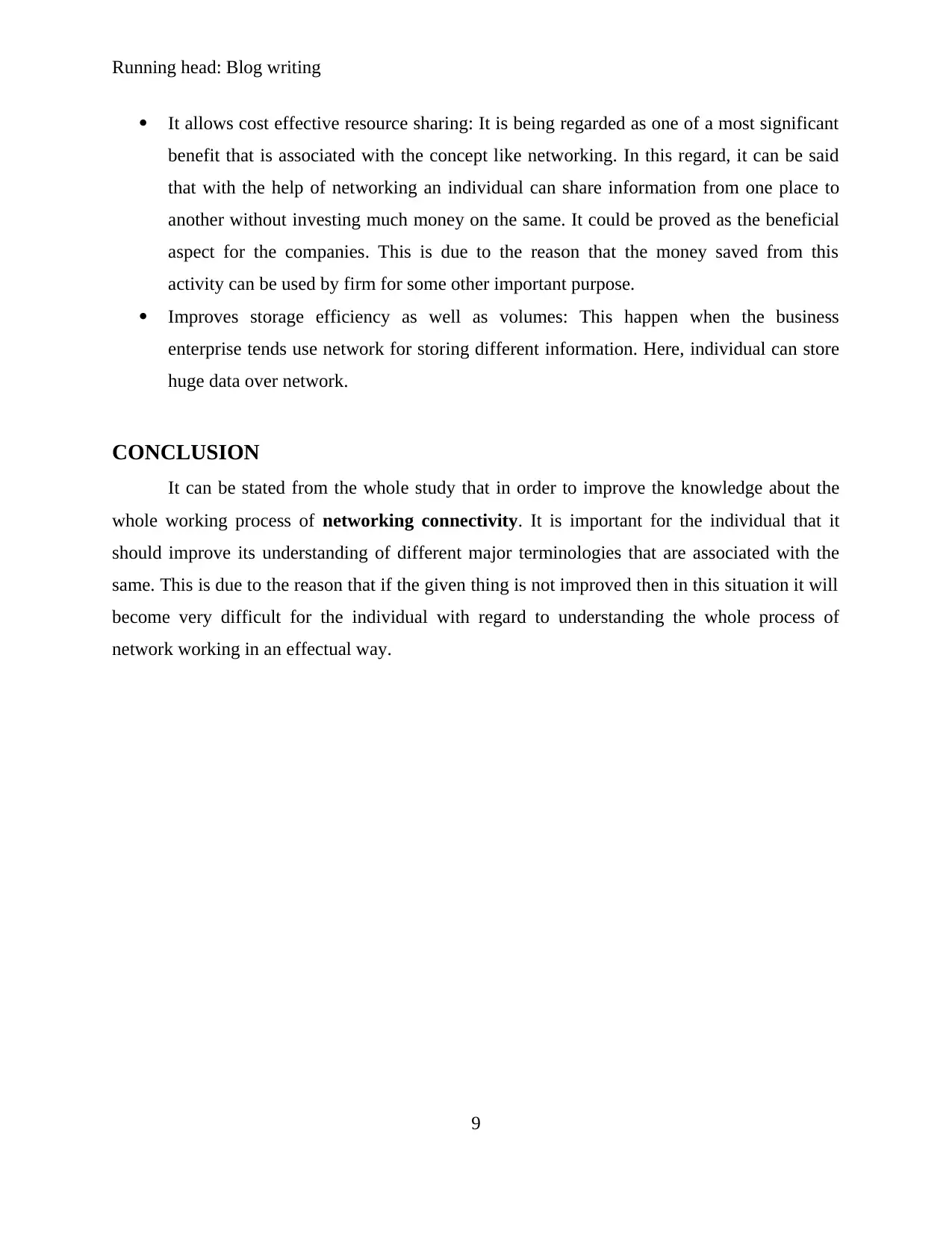
Running head: Blog writing
It allows cost effective resource sharing: It is being regarded as one of a most significant
benefit that is associated with the concept like networking. In this regard, it can be said
that with the help of networking an individual can share information from one place to
another without investing much money on the same. It could be proved as the beneficial
aspect for the companies. This is due to the reason that the money saved from this
activity can be used by firm for some other important purpose.
Improves storage efficiency as well as volumes: This happen when the business
enterprise tends use network for storing different information. Here, individual can store
huge data over network.
CONCLUSION
It can be stated from the whole study that in order to improve the knowledge about the
whole working process of networking connectivity. It is important for the individual that it
should improve its understanding of different major terminologies that are associated with the
same. This is due to the reason that if the given thing is not improved then in this situation it will
become very difficult for the individual with regard to understanding the whole process of
network working in an effectual way.
9
It allows cost effective resource sharing: It is being regarded as one of a most significant
benefit that is associated with the concept like networking. In this regard, it can be said
that with the help of networking an individual can share information from one place to
another without investing much money on the same. It could be proved as the beneficial
aspect for the companies. This is due to the reason that the money saved from this
activity can be used by firm for some other important purpose.
Improves storage efficiency as well as volumes: This happen when the business
enterprise tends use network for storing different information. Here, individual can store
huge data over network.
CONCLUSION
It can be stated from the whole study that in order to improve the knowledge about the
whole working process of networking connectivity. It is important for the individual that it
should improve its understanding of different major terminologies that are associated with the
same. This is due to the reason that if the given thing is not improved then in this situation it will
become very difficult for the individual with regard to understanding the whole process of
network working in an effectual way.
9
1 out of 10
Related Documents
Your All-in-One AI-Powered Toolkit for Academic Success.
+13062052269
info@desklib.com
Available 24*7 on WhatsApp / Email
![[object Object]](/_next/static/media/star-bottom.7253800d.svg)
Unlock your academic potential
Copyright © 2020–2025 A2Z Services. All Rights Reserved. Developed and managed by ZUCOL.





